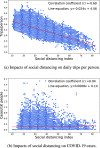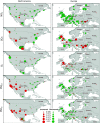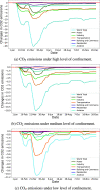Machine Learning on the COVID-19 Pandemic, Human Mobility and Air Quality: A Review
- PMID: 34786314
- PMCID: PMC8545207
- DOI: 10.1109/ACCESS.2021.3079121
Machine Learning on the COVID-19 Pandemic, Human Mobility and Air Quality: A Review
Abstract
The ongoing COVID-19 global pandemic is touching every facet of human lives (e.g., public health, education, economy, transportation, and the environment). This novel pandemic and non-pharmaceutical interventions of lockdown and confinement implemented citywide, regionally or nationally are affecting virus transmission, people's travel patterns, and air quality. Many studies have been conducted to predict the diffusion of the COVID-19 disease, assess the impacts of the pandemic on human mobility and on air quality, and assess the impacts of lockdown measures on viral spread with a range of Machine Learning (ML) techniques. This literature review aims to analyze the results from past research to understand the interactions among the COVID-19 pandemic, lockdown measures, human mobility, and air quality. The critical review of prior studies indicates that urban form, people's socioeconomic and physical conditions, social cohesion, and social distancing measures significantly affect human mobility and COVID-19 viral transmission. During the COVID-19 pandemic, many people are inclined to use private transportation for necessary travel to mitigate coronavirus-related health problems. This review study also noticed that COVID-19 related lockdown measures significantly improve air quality by reducing the concentration of air pollutants, which in turn improves the COVID-19 situation by reducing respiratory-related sickness and deaths. It is argued that ML is a powerful, effective, and robust analytic paradigm to handle complex and wicked problems such as a global pandemic. This study also explores the spatio-temporal aspects of lockdown and confinement measures on coronavirus diffusion, human mobility, and air quality. Additionally, we discuss policy implications, which will be helpful for policy makers to take prompt actions to moderate the severity of the pandemic and improve urban environments by adopting data-driven analytic methods.
Keywords: COVID-19; air quality; coronavirus; human mobility; machine learning; pandemic; public health; review; spatio-temporal analysis.
This work is licensed under a Creative Commons Attribution 4.0 License. For more information, see https://creativecommons.org/licenses/by/4.0/.
Figures









References
-
- Silva P. C. L., Batista P. V. C., Lima H. S., Alves M. A., Guimarães F. G., and Silva R. C. P., “COVID-ABS: An agent-based model of COVID-19 epidemic to simulate health and economic effects of social distancing interventions,” Chaos, Solitons Fractals, vol. 139, Oct. 2020, Art. no. 110088. - PMC - PubMed
-
- He G., Pan Y., and Tanaka T., “The short-term impacts of COVID-19 lockdown on urban air pollution in China,” Nature Sustainability, vol. 3, no. 12, pp. 1005–1011, Dec. 2020.
LinkOut - more resources
Full Text Sources
Miscellaneous
